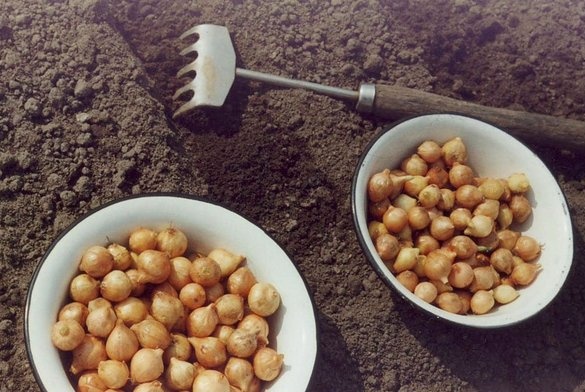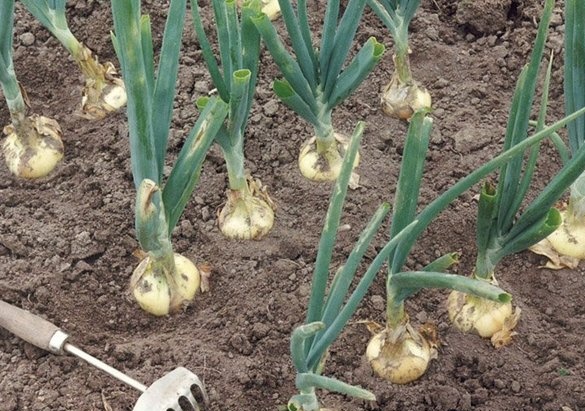Sevc is planted in prepared and fertilized soil. Before planting, the seeds are sorted out, removing dried and diseased bulbs. Effectively pre-sowing heating sowing for 8 hours at a temperature of +40 ... 42 ° C. This can be done on heating batteries, scattering sevok on a board (thicker) with sides.
Before planting the onion sets, soak in warm water (+35 ... 42 ° C) with the addition of potassium permanganate (1 g per 5 l of water) for 2-6 hours. Then drain the water and spread the sevoc onto a film or burlap, covering it on top. If this work is done on the eve of planting, then some onions will have roots.
If after planting a seed set the air temperature for a long time (possibly a month or more) is kept at +10 ... 15 ° C, many large onions give a flower arrow. Therefore, it is important to choose the right landing time. Shallow sowing can be planted at the earliest possible time, as soon as the soil allows, because he does not shoot even in the conditions of a long cold spring. Plant large and medium sets at the same time by planting early potatoes, i.e. when the soil warms up to +8 ... 10 ° С.
If there is enough moisture in the soil, then an early planting of planting contributes to the rapid development of roots, and well-rooted plants are less affected by the onion fly. Plantings can be temporarily compacted by planting sowing and between the lines for sampling on greens, but it must be removed no later than mid-June. In no case do not tear off the “feathers” from the onions, which grow both on the turnip and to the north, for summer salads. Bulbs are poured from leaves, when plucking them we ourselves reduce the yield. Plant on greens separately.
After fertilizing and spring digging the soil for planting the seed, make a low ridge about 1 m wide. The distance between the rows for the seed is 20-25 cm, in the row 10-15 cm. The depth of planting depends on the soil and the size of the seed, but the most important thing is that the whole the onion was in a moist layer of soil.
A comb ridge planting is very effective. It is done like this. Having loosened the soil on the bed with a pitchfork to a depth of 10-12 cm and leveled with a rake, make grooves across the ridges with a depth of 2-3 cm, the distance between them is 20-25 cm for small and medium-grained cultivars and 30 cm for multi-germ grades. Water the ridge abundantly, add 100 g of wood ash to the grooves and spread the bulbs at a distance of 10-15 cm.Then row rows, rake the soil from the row-spacings. Combs are obtained, the bulbs are completely covered by soil. The larger the shelter, the better.
The advantage of this method is that under the onion there is loose soil (when you press the onion, the soil is compacted under it), then the roots grow well. Bulbs in the crest warm better than buried in the soil. In the event of a cold snap, they are covered, and less likely that they shoot themselves.
The comb planting protects the onion from the most dangerous pest - the onion fly, because its larvae do not reach the bottom of the bulb due to the long distance and die.
Gradually, the ridges collapse under the influence of irrigation and wind, and by the time the bulb is formed, it is not necessary to rake the ground with your hands.
Plant care is common: during the summer, weed and loosen 4-5 times, watered and fed if necessary. In the first month, in the absence of rain, plants are regularly watered, spending about 15 liters of water per 1 sq. Km. m. After irrigation, the soil must be loosened.
If the plants grow weakly, then 10-12 days after planting, they can be fed with a solution of mullein (1:10) or bird droppings diluted 15-20 times with water. 25 g of urea is added to a bucket of such a solution, spending 10 liters of solution per 3-4 square meters. m
Perform the second feeding 20 days after the first: 15 g of urea, 15 g of superphosphate and 40 g of potassium salt per 10 liters of water. The third top dressing is given when the bulbs are formed. 20-30 g of superphosphate and 15 g of potassium salt are diluted in 10 l of water. Top dressing is carried out after watering.
The time of harvesting turnip onions is determined by lodging and yellowing of the leaves in the bulk of the bulbs, drying of the neck, false stem and the formation of one or two dry scales with a characteristic color of the variety.

Attention! You can’t be late for onion harvesting, as plants can move to secondary growth.
Onions are selected from the soil, laid out on ridges for drying. When drying the sun onions less affected by neck rot than when drying in the shade under a canopy. If it rains, then spread the onion in a thin layer in a well-ventilated area.
Roots and leaves are cut off on the dried onion, leaving a false stem 3-5 cm long. Such pruning excludes the penetration of neck rot and downy mildew pathogens into the onion. When pruning, small (up to 4 cm) bulbs (samples) are sorted, as well as sick and unripe (with a thick neck). They can be stored only after additional drying.
Bow. Tips for growing onion sevka
Onions cannot be spudded, only to loosen the earth around it.
There’s a technique like "wallow"onions. Previously, it was believed that it accelerates the ripening of onions. However, this technique is artificial. Experienced gardeners never bend the feather - the neck of the onion is very fragile. A broken feather can rot, and from it the entire bulb. To accelerate the ripening of the onion, just stop watering two weeks before harvesting, and on wet days you can also scoop up the soil from the bulbs.
Only fully ripened onion heads are well stored. In well-dried onions, all leaves dry out and the neck "closes". When removing the onion for storage, the neck is cut 3-4 cm from the bulb. But bulbs with a thick, not closed neck or crumbled outer scales, as well as very large ones, will not last long, therefore they should be used first of all.
An interesting experience is the Tver peasants who, before laying for storage for a long time, up to a day, warm onions in a melted, but already cooling furnace at a temperature of 40-50 ° C. As a result, such a heated onion does not germinate throughout the winter.
Although the onion and cold-resistant culture, it is still impractical to store it at a temperature below minus 3 ° C. And during storage, it is important to prevent the formation of condensate, i.e. drip moisture on the surface of the bulb, which can occur with sharp fluctuations in temperature. A damp onion starts to grow, its temperature rises, which leads to the germination and damage of the bulbs. It must be remembered that the further growth of already sprouted bulbs cannot be stopped, even if they are placed in a room with a low temperature.In addition, moist external onion scales become vulnerable to various microorganisms, which also leads to damage to the onion.
The introduction of fresh manure under onions delays the ripening of bulbs and increases the risk of pests.
It is useful to plant several dill plants on a bed with onions: dill will repel pests.
Onions and garlic love to have a lot of sulfur in the soil. Sulfur-containing fertilizers: superphosphate, potassium sulfate, ammonium sulfate. A small (with a diameter of up to 1 cm) seedling is best planted in the fall in the winter, as in home storage conditions, it dries.
On a green feather in early spring, it is better to plant turnip onions or samples. Planted on a low (12cm) bed by the bridge method: close, bulb to bulb. Moreover, the bulbs are not covered with earth, they are on the surface of the soil. Usually 1 sq.m planted on feather 8-10kg. After planting, the onions are well shed with water (10 l per 1 sq. m) and covered with a film on top. During growth, the onions are fed once with a urea solution (1 tablespoon per 10 l of water). The onions are watered more often, after about 2-3 days, 10-15l per 1sq.m. With this method of planting, good green e pen (c1 sq.m receive 10-12kg green onions) and the very flesh is firm and edible.
Leek seedlings should be planted deep. Furrows are made to a depth of 15 cm, the excavated soil is folded onto the ridges, and plants are placed at the bottom of the furrow through 20-25 cm, making a recess under each peg so that the roots do not turn upward. It is necessary to plant to the level at which the stem begins to disperse on the leaves. Further, as the seedlings grow, they add soil from the ridges to the plants until the groove is level with the ground. And in order for the leek to be more authentic and whiter, in the future you can increase the sides of the beds and fill it with loose peat or sawdust.
Before planting, in seedlings of leeks, the roots are slightly shortened (up to 2-3 cm) and the leaves are cut to 1/3 of the length.
In chives, it is better to cut off all the leaves at once, and not to choose individual feathers, since its leaves should be rejuvenated. They even advise cutting it off when the feathers are not needed for food, just to stimulate the rejuvenation of the bush. Usually, chives - onions are cut from April to November. And the more often he cuts off his feather, the more the development of peduncles is delayed.
Vegetable growers believe that when transplanting leek seedlings to a permanent place in the ground, it is important to take into account the orientation of the plants. They must be planted so that the plane of the leaves runs along the row, and not across, otherwise the growing leaves will close the aisles and it will be difficult to process the plants: weeding, loosening, watering.
You can store onion sets all winter in the sand. To do this, sand is poured into a bucket (without earth and clay impurities, previously calcined) with a layer of 10 cm, then the sevka is laid out, then again a layer of sand, sevok, etc. The top layer of sand is covered with a rag. Such a bucket with onions and sand can be kept in the room.


